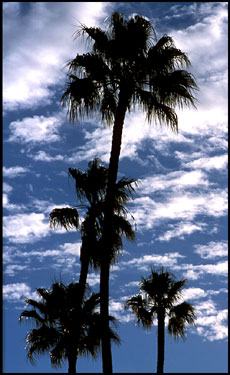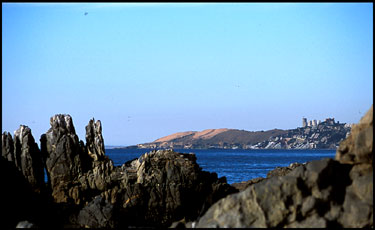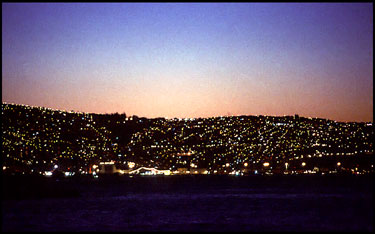Day 9-10: Santiago, Viña Del Mar, Quillota
from Photographs of Chile, November 2003 by Tim Darling
(Click on the photos..)
Saturday, November 8 - Santiago, Viña Del Mar
I walked into a bookstore on Providencia and an old man handed me
some English language books over a stack of books in Spanish. Almost all of them had
titles
like 'Experiments in Perversion' and 'The Tentative Lesbian'.
Maybe if it had been titled 'The Totally Nympho Lesbian,' I would have been more
interested, but instead I went with another pulp fiction with the clinching title
'The DA Goes to Trial'.
 I think Viña del Mar may be a mad house. Partly because of its complete
adversity to any level of organization and partly because of the honest
happiness on every face. There's accordion music and the sound of
children crowding a swingset drifting through my hotel window which
overlooks Plaza Colombia by the sea. Walk into a restaurant and it's not
always obvious who's serving who. Wherever there's a cash register I
swear there's always someone abusing it like a monkey at a toy piano. I
felt much less like an outsider in Viña than anywhere else in Chile so far. I
mean, who can't fit in in a crazy place?
I think Viña del Mar may be a mad house. Partly because of its complete
adversity to any level of organization and partly because of the honest
happiness on every face. There's accordion music and the sound of
children crowding a swingset drifting through my hotel window which
overlooks Plaza Colombia by the sea. Walk into a restaurant and it's not
always obvious who's serving who. Wherever there's a cash register I
swear there's always someone abusing it like a monkey at a toy piano. I
felt much less like an outsider in Viña than anywhere else in Chile so far. I
mean, who can't fit in in a crazy place?
I checked my watch and it was about 6. Before leaving, I had talked to
my friend Jeff, who, besides being the bass player for the Worry Stones,
also
painted what became the cover of the band Virginia Coalition's first album. (You
can see photos of both bands elsewhere on this site). He had dropped out
of school for a few months and during that time, had lived in Viña Del
Mar. Talking to him about it, I suggested that it might be fun to try to
get a photograph of the spot that he had painted. For one thing, if you
don't know anything about a city, it makes it a lot more fun and welcoming
if you have at least one thing you want to see or do when you get there.
Jeff said that when he lived there, he and his friends would sit on their
porch by the street and play guitar and sing in the evening. But this
was during the Socialist rule and the police would occassionally stop
by and arrest his friends (they didn't arrest Americans, apparently).
So his friends would hand him their their guitars and he'd carry them
home for them.
Anyway, this album cover (you can see it here) is of the Reloj de Flores
(Flower Clock) and the surrounding area on the south side of the
beach. Jeff said the perspective was from a point in the ocean looking
inland, but when I got there, I realized that I would have to be at least
a hundred feet above the ocean to get it because there's a cliff/wall that
is at least fifty feet high coming up from the ocean; and over the
top of that, there is another few hundred feet of trees, swingsets, and
ice cream stands inland.
 But I found a spot on the road that looked about right. The clock
looked OK, even the red Coca Cola stand on the right side was in about the
right place. Funny thing was, instead of the green diabolic face that was
in the painting, there was a tree in about the same spot that, with a bit
of imagination, looked very similar.
But I found a spot on the road that looked about right. The clock
looked OK, even the red Coca Cola stand on the right side was in about the
right place. Funny thing was, instead of the green diabolic face that was
in the painting, there was a tree in about the same spot that, with a bit
of imagination, looked very similar.
I needed to get a little bit higher, so I found a red plastic traffic
barrier and lugged it over to the spot on the grass. It was pretty
heavy. I thought, good thing J and J aren't here, or they'd probably try
to take it to Argentina with them.
Then at 6:55 (same as the time in the painting), I stood on it and lined
up the shot. A traffic cop came over and was very upset that I'd moved
his barrier. I hadn't yet heard the crunching of any cars crashing, so I
promised to return it if he gave me a minute to take a photo. I took a
couple shots and then carried it back and he applauded. He was nice about
it,
spoke a little English, and said he had a son in California. I showed him
the album cover and explained what I was doing. He studied it
intently. When I left, he shook my hand and said 'bye bye' in
English. All for just stealing his traffic barrier.
Viña looks a bit like Monte Carlo with its tall thin, pastel-colored
buildings by the sea with prominent curved balconies (the word 'honeycomb'
comes to mind). It also has curvy roads and a casino (though, where MC
has Lamborghinis and Ferraris parked out front, Viña has Hondas and
Vauxhalls.) It has more street-side bakeries than any French town that
I've walked through. It has the public display of affection level of its
fellow
Spanish-speaking city, Madrid. And it has the organizational disarray of
a model Italian city. So really, it's many pieces of Europe in one spot.
 (Looking north to Viña from Valparaiso)
(Looking north to Viña from Valparaiso)
Walking back north along the La Marina road that runs along the beach,
kids as young as ten or twelve would suddenly fall into each other's arms
in front of me, their faces squashing into a single shadow in the
dusk. Where the sidewalk ran a few feet above the edge of a stretch of
sand (a lot of Viña's beaches are large rocks), the smoke from joints
rose up from huddles of laughing kids below. Then suddenly it hit me: the
complete lack of organization, the overly friendly and happy
people. 'Mad house' still wasn't too far off, but there was more to the
explanation that just that.
Later that night, I saw a lunar eclipse as I
walked over a bridge back into the north half of town. "There's no dark
side of the moon really.. as a matter of fact it's all dark," a voice
somewhere explained.
Sunday, November 9 - Viña Del Mar, Quillota (key-oh-ta)
 (Looking south from Viña to Valparaiso at night)
(Looking south from Viña to Valparaiso at night)
"Whoever called 'Valparaiso' the 'Valley of Paradise' must have been
thinking of Quillota!... Quillota, which is more like a
collection of nursery gardens than a town," wrote Charles Darwin in August
1839 (I was flipping through his diaries from the HMS Beagle before I
left). Since Quillota is thirty kilometers east of Viña, it seemed like a
trip worth taking.
Darwin wrote his account of Quillota in his diaries during his travel there in 1834 and published
it, without any mention of his theories, to avoid negative attention from the controversial ideas that he was
secretly developing. The Beagle
was tasked with mapping the outline of South America and he went along for five years as the guest
of the captain. It was there, during a long land trek around Santiago (and during an earlier stop in the
southern part of the continent) that he discovered the different species of rheas and armadillos that
provided the first evidence to him of evolution. The Beagle didn't make it to the Galápagos Islands
until about a year later: in The Origin of the Species, Darwin starts out with "I was struck with
certain facts in the distribution of the inhabitants of South America... [that] seemed to me to throw
some light on the origin of species..." The Galápagos finches don't appear until much later in the book.
I caught a bus there and found it was flat and dry with wide streets and
palm trees and mostly residential areas, not unlike a small suburb in
southern California. There were mountains on all sides so I set off on
the nearest street towards them to the east. They looked like they were
maybe an hour's walk away.
The road crossed railway tracks and the developments turned into farms
with plants under long plastic canvas roofs and a couple women with a
young kid on a tricycle stepped out from a house hidden behind a tree and
a cool breeze went by. The road came to an end and turned right, running
along the bottom of the mountains. I went with it, looking for a
'camino' that I could walk up and look down on Quillota from. Miles
passed with no luck. The mountains began to smooth out and Quillota was
far behind me.
Then without warning, I saw a big green field to the left with eight men
on horses playing polo, and they were even properly dressed for it! I
walked further on, looking for a spot to photograph them from.
A hundred yards later, I came across a surprising sign on the side of the
fence between me and them: 'No entrada. Zona Militar'. I turned to the
other side of the road and saw a similar sign though it, more
conventionally, was nailed to a tall concrete wall topped with barbed
wire. A little further on, a sign on the road clearly announced that
I was indeed entering a 'Zona Militar' and a row of well-manicured lawns
and square houses lined up along the right side of the road seemed
to verify
that. On the left, the polo field changed to what looked like an
equestrian club, with gardens, horse jumps, and a clubhouse. As I walked
on, I passed large metal gates that were complete with what could have
easily a horse farm logo- a shield with a large 'E' on it. This latest
addition only made the two guards holding automatic rifles behind it look
all the more out of place. They stared as I passed, an American far off
any tourist route with thousands of dollars worth of camera equipment and
high speed film in his backpack.
Was the Chilean military just a well-armed polo team?, I wondered. I
guess there's crazy surprises to be found everywhere, but this was one that
I wasn't crazy enough to try and photograph.
A couple miles later, I was in another small town called San Pedro. I
walked into a small store and took a bottle of juice from the
refrigerator. The woman behind the counter shook her head and said "no
no no, don't take that one, it's poison! We only have that in there to confuse American tourists." Actually
I have no idea what she said but she seemed happier when I picked out
another bottle. I waved at a passing cab and he waved back. So I caught
a bus back to Quillota and another one back to Viña, with only a couple
photos to show for a day's work and the thought that using a 165-year old
journal as a travel guide was probably destined to at best bring mixed
success.
 Day 11-12: Valparaiso, Viña Del Mar
Day 11-12: Valparaiso, Viña Del Mar
Your Comments
About the Polo team. Sure you stepped around the "Escuela de Caballer a de Quillota" (literally cavalry school). Even though it's technically an army estate, there are some areas open to the public. This includes the equestrian installations that often host competitions both local and international, including polo.
-- Erich Strelow, Nov 2, 2007
I love chile!
-- Meaket, May 1, 2008
Add a comment
All text and pictures copyright © 2003 Tim Darling.
 I think Viña del Mar may be a mad house. Partly because of its complete
adversity to any level of organization and partly because of the honest
happiness on every face. There's accordion music and the sound of
children crowding a swingset drifting through my hotel window which
overlooks Plaza Colombia by the sea. Walk into a restaurant and it's not
always obvious who's serving who. Wherever there's a cash register I
swear there's always someone abusing it like a monkey at a toy piano. I
felt much less like an outsider in Viña than anywhere else in Chile so far. I
mean, who can't fit in in a crazy place?
I think Viña del Mar may be a mad house. Partly because of its complete
adversity to any level of organization and partly because of the honest
happiness on every face. There's accordion music and the sound of
children crowding a swingset drifting through my hotel window which
overlooks Plaza Colombia by the sea. Walk into a restaurant and it's not
always obvious who's serving who. Wherever there's a cash register I
swear there's always someone abusing it like a monkey at a toy piano. I
felt much less like an outsider in Viña than anywhere else in Chile so far. I
mean, who can't fit in in a crazy place?
 But I found a spot on the road that looked about right. The clock
looked OK, even the red Coca Cola stand on the right side was in about the
right place. Funny thing was, instead of the green diabolic face that was
in the painting, there was a tree in about the same spot that, with a bit
of imagination, looked very similar.
But I found a spot on the road that looked about right. The clock
looked OK, even the red Coca Cola stand on the right side was in about the
right place. Funny thing was, instead of the green diabolic face that was
in the painting, there was a tree in about the same spot that, with a bit
of imagination, looked very similar.
 (Looking north to Viña from Valparaiso)
(Looking north to Viña from Valparaiso)
 (Looking south from Viña to Valparaiso at night)
(Looking south from Viña to Valparaiso at night)
 Day 11-12: Valparaiso, Viña Del Mar
Day 11-12: Valparaiso, Viña Del Mar